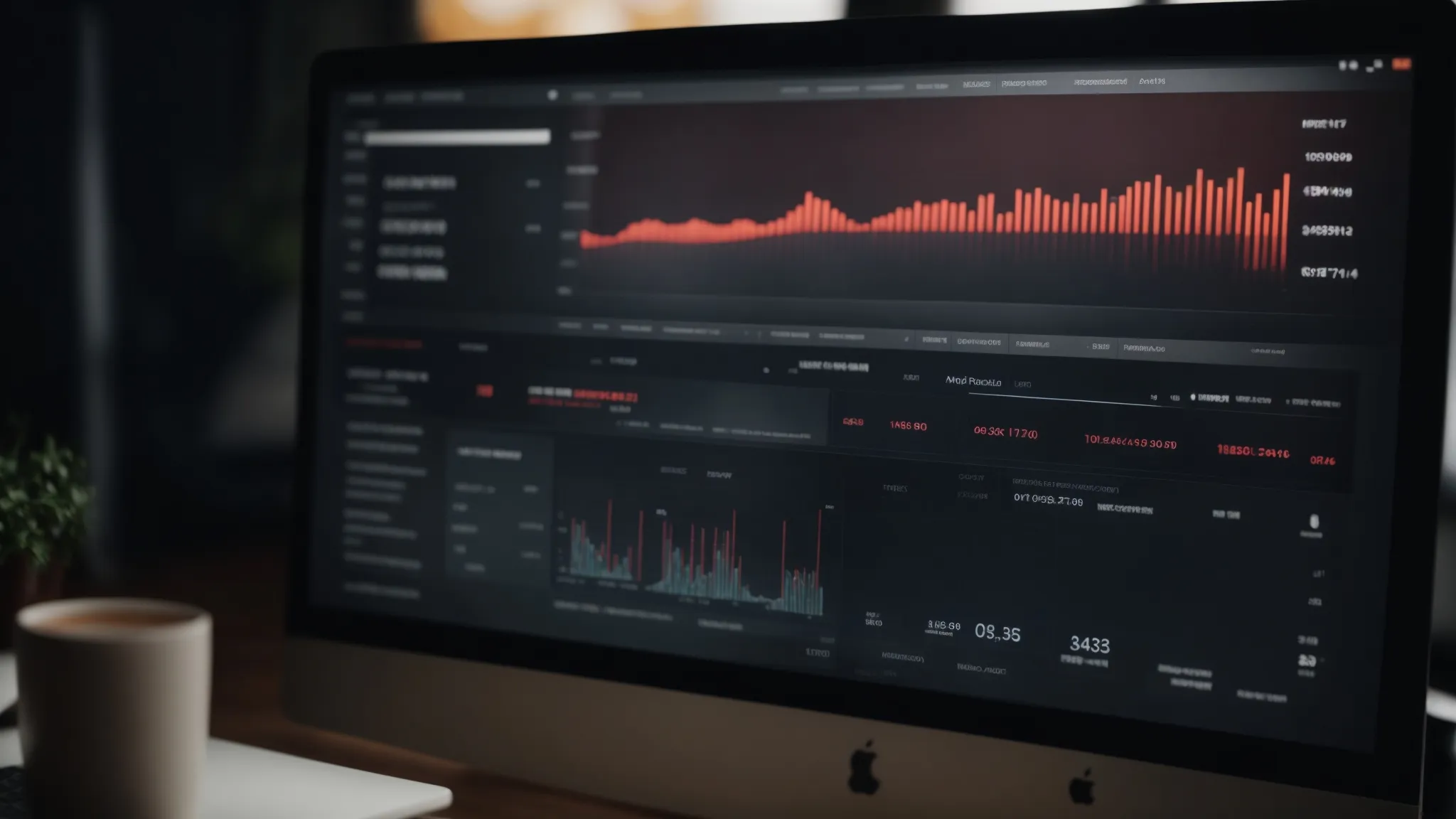Increase Web Traffic with Image Sitemap Optimization
Boost Your Site’s Visibility: Mastering Image Sitemap Optimization In the dynamic realm of SEO, image sitemaps represent an invaluable yet often overlooked arsenal for elevating a site’s […]
Boost Your Site’s Visibility: Mastering Image Sitemap Optimization
In the dynamic realm of SEO, image sitemaps represent an invaluable yet often overlooked arsenal for elevating a site’s presence in search results.
Beyond mere visual appeal, optimized images attract search engine crawlers and enhance user engagement, offering an untapped potential to boost a site’s visibility.
LinkGraph’s SEO services recognize the significance of these elements, integrating comprehensive image sitemap strategies to propel websites to the forefront.
This article will illuminate the path to mastering image sitemap optimization, disclosing best practices that sharpen competitive edges.
Keep reading to unlock the full potential of your visual content in the digital landscape.
Key Takeaways
- Image Sitemap Optimization Is Vital for Improved Indexing and Search Rankings
- LinkGraph Employs Search Atlas to Enhance the Visibility and Indexing of Clients’ Visual Content
- Geolocation Tagging Can Significantly Boost a Website’s Presence in Local Search Results
- Regular Updating and Monitoring of Image Sitemaps Are Crucial for Maintaining Relevance in Search Engines
- Analytics Play a Key Role in Refining Image SEO Strategies and Demonstrating the Effectiveness of Optimization Efforts
Unveiling the Benefits of Image Sitemap Optimization

In today’s visually-driven online landscape, the strategic utilization of image sitemaps can be a game-changer for websites aiming to enhance their digital footprint.
A carefully crafted image sitemap not only aids search engines in discovering visual content more efficiently but also paves the way for improved indexing.
As websites interweave the technical sophistication of SEO with the aesthetic appeal of high-quality imagery, they witness a notable uplift in their search rankings.
By optimizing image sitemaps, site owners and webmasters send a clear signal to search engines, magnifying the prominence of their visual offerings and ensuring that those images earn their rightful place in the search results.
Enhance Discoverability of Your Visual Content
Embracing the prowess of image sitemap optimization, organizations like LinkGraph empower businesses to propel their visual content into the spotlight for search engines. The intricate process of constructing an image sitemap amplifies the visibility of images, allowing them to be meticulously indexed and served to users with relevant search queries, thereby driving traffic and engagement.
By integrating LinkGraph’s Search Atlas features, entities can seamlessly infuse the digital architecture of their site with robust mechanisms that enhance the discoverability of multimedia assets. This strategic thrust not only elevates user experience but also significantly bolsters the image’s potential to contribute to the overall SEO fortitude of the website.
Increase the Likelihood of Image Indexing
Optimizing an image sitemap can significantly raise the probability of indexing by search engines. This digital beacon serves as a guide, directing crawlers to the essence of a site’s visual narrative, thus improving the accuracy and depth of image indexing.
Switching the focus towards Image Sitemap Optimization, LinkGraph introduces precision into this realm, employing Search Atlas to ensure every image tag is Meticulously Crafted for Optimal Recognition. This advanced approach streamlines the connection between visual content and search algorithms, enhancing the indexation process to benefit a site’s visibility and user reach.
Improve Image Search Rankings
Attaining elevated image search rankings is a critical aspect of digital strategy, and this is where LinkGraph’s proficiency shines. Their adept use of Search Atlas SEO tools ensures that images are not only indexed but also rank prominently, encouraging a surge in organic traffic.
LinkGraph’s commitment to SEO excellence helps clients to navigate the complexities of image optimization with ease. By harnessing the power of Search Atlas, webmasters can watch their visual content ascend through the ranks, becoming more accessible to users and more integral to search engine results.
Crafting an Effective Image Sitemap Strategy

To solidify a website’s presence in the competitive digital sphere, mastering the intricacies of an image sitemap is crucial.
This advanced level of optimization necessitates a keen understanding of which images are deemed most valuable, thereby warranting inclusion.
LinkGraph’s wizardry extends to unraveling this complexity by guiding enterprises in identifying and prioritizing their key images.
Furthermore, they offer sagacious advice on structuring an image sitemap that flows cohesively with the overall site architecture.
Implementing such a sitemap is more than a mere procedural step; it is a strategic integration that can substantially augment a site’s exposure and search engine traction.
Identify and Prioritize Key Images for Inclusion
In the quest for heightened visibility, discerning which visual elements carry the most weight in terms of SEO significance is critical. LinkGraph assists clients in the meticulous selection of images that not only captivate the audience but also align with search engine algorithms for increased relevance and impact.
Once the pivotal images have been earmarked, the ensuing step involves the organization of these assets into a structured hierarchy:
- Evaluating image attributes such as relevancy, file size, and quality.
- Assigning descriptive, keyword-rich file names and alt text to each image.
- Creating an XML image sitemap that references these optimized visual assets.
This focused approach ensures that a site’s most potent visual messages gain prominence in the search engine landscape, providing a competitive edge and driving organic traffic to the site.
Map Out the Structure of Your Image Sitemap
Addressing the architecture of an image sitemap with rigor is a cornerstone of LinkGraph’s strategy. Their expert teams work hand-in-glove with clients, formulating a blueprint that aligns with the overarching SEO goals of the site.
Certain critical steps must be followed when delineating the structure of an effective image sitemap:
- Integrate the image sitemap with the existing XML sitemap or create a dedicated sitemap exclusively for images.
- Include comprehensive metadata for images, such as captions, geographic location, and license information, to enhance relevancy.
- Update the sitemap regularly to reflect any new images or changes to existing images to keep the content fresh and current for search engines.
LinkGraph, utilizing its proprietary Search Atlas SEO tools, ensures each of these steps is executed with precision, securing the image sitemap’s pivotal role in catapulting a site’s search visibility to new heights.
Integrate Your Sitemap Into Your Site’s Architecture
LinkGraph’s SEO services facilitate the seamless integration of image sitemaps into a website’s existing hierarchy, enhancing a site’s ability to communicate effectively with search engines. Their approach involves embedding a comprehensive sitemap that coexists with the website’s current navigation, ensuring that images are easily accessed by search engine crawlers for better indexing.
Through careful application of Search Atlas tools, LinkGraph supports webmasters in constructing a site architecture that includes optimized image sitemaps which navigate users and search engines alike to the most visually compelling content. This strategy not only enriches the user journey but also emphasizes the significance of the website’s images in search rankings.
Essential Elements for High-Performance Image Sitemaps

To elevate a website’s stature in the digital arena, curating high-performance image sitemaps is indispensable.
Marketers and webmasters must refine each visual element’s metadata, harnessing practices to optimize search engine visibility.
By employing descriptive titles and captions, utilizing effective alt text, and capitalizing on geolocation tagging, LinkGraph crafts a detailed tapestry of information for search engines.
This meticulous approach underpins the visual content with robust SEO foundations, aiding in higher search rankings and enhanced user engagement.
Utilize Descriptive Titles and Captions
The precision in fashioning descriptive titles and captions lies at the heart of image sitemap optimization, with LinkGraph leading the strategic initiative. Prioritizing Clarity and Relevance, LinkGraph advises clients to enrich their visual assets with titles and captions that mirror the content type and subject matter, enhancing the contextual interpretation by search engines.
LinkGraph’s execution of white-label SEO services entails crafting captions that not only narrate the visual story but also incorporate targeted keywords, boosting the image’s visibility in search results. This attention to detail ensures that each image contributes significantly to the site’s search engine rankings, fostering greater user engagement with the visual content on offer.
Implement Alt Text for Image SEO
Implementing astute alt text for images has become pivotal in the tapestry of SEO practices, and LinkGraph intricately understands its magnitude. Alt text provides succinct yet descriptive information about the visual, ensuring that even when images are not rendered, their essence is readily communicated to search engines and users alike.
This textual descriptor serves a dual purpose: aiding accessibility by describing images to visually impaired users and enhancing SEO value by embedding relevant keywords. LinkGraph excels in refining this component, Ensuring the Alt Text Strikes a Balance between accessibility and keyword optimization.
- Understand the visual content and provide a concise description.
- Incorporate relevant keywords without overstuffing.
- Ensure compatibility with the context in which the image is used.
Leverage the Power of Geolocation Tagging
Geolocation tagging stands as a beacon of contextuality in the realm of image sitemap optimization. When enterprises tag images with precise geographical data, they spotlight locale-specific visuals, catering to local search queries and amplifying relevance in regional search results.
Incorporating geolocation tags into an image’s metadata taps into the localized aspects of SEO, giving businesses a firmer foothold in area-specific markets. Such strategic inclusion is vital for companies aiming to dominate local search landscapes and LinkGraph, through its comprehensive SEO services, ensures clients can harness this potential to the fullest:
| SEO Element | Role in Local SEO | Impact on Image Sitemaps |
|---|---|---|
| Geolocation Tagging | Targets regional audience | Improves relevance and visibility in local search results |
| Metadata Optimization | Enhances local search signals | Assists in indexing and ranking of geographically pertinent images |
| Localized Keywords | Attracts local traffic | Integrates regional search terms into image descriptions for higher ranking potential |
Incorporating Image Sitemaps Into Your SEO Toolbox

As digital marketers untangle the complexities of SEO, the inclusion of image sitemaps emerges as a pivotal element in broadening a website’s visibility.
A cohesive SEO strategy, enriched by the integration of well-optimized image sitemaps, can yield remarkable returns, elevating a website’s profile and searchability within the digital tapestry.
It is essential for website owners to not only weave these sitemaps into their existing optimization efforts for synergistic effects but also to commit to ongoing performance evaluations and timely updates.
LinkGraph, with its esteemed acumen, enables businesses to master this optimization process, ensuring their visual content is meticulously indexed and remains perpetually poised to capture audience attention efficiently.
Combine With Existing SEO Tactics for Synergistic Effects
LinkGraph’s expertise in image sitemap optimization harmonizes with existing SEO tactics, creating a multiplicative effect on a site’s online presence. Through strategic integration, image sitemaps complement on-page and off-page SEO efforts, establishing a solid foundation for comprehensive search engine visibility.
The intelligent synergy of image sitemaps with broader SEO strategies by LinkGraph involves combining several critical elements to maximize search engine appeal:
- Conducting a thorough SEO audit to identify opportunities for optimization.
- Aligning content strategy and keyword targeting with image sitemap metadata.
- Ensuring backlink analysis includes image URLs to enhance the link building process.
With these concerted efforts, LinkGraph positions its clients’ sites for amplified exposure and reach, securing a competitive edge in the highly dynamic digital ecosystem.
Monitor Image Sitemap Performance Regularly
Regular monitoring is the cornerstone of maintaining a high-performing image sitemap. LinkGraph provides businesses with the tools and insights needed to track the performance and impact of their image sitemaps, ensuring they continue to propel visibility and improve search rankings effectively.
With diligent evaluation, LinkGraph enables site owners to respond promptly to shifts in search engine algorithms and user behaviors:
- Review image metrics to gauge enhancements in traffic and engagement.
- Analyze search rankings to determine the effectiveness of metadata optimizations.
- Update image sitemaps to reflect changes in content and ensure alignment with current SEO objectives.
By prioritizing this continuous improvement cycle, LinkGraph ensures image sitemaps serve as an enduring asset in the site’s SEO arsenal, consistently driving forward both user experience and search engine relevance.
Update Your Sitemap to Reflect New Images and Changes
To sustain a dynamic online presence, constant refinement of image sitemaps is critical. LinkGraph emphasizes the importance of updating sitemaps to account for new images and recent modifications, ensuring the most up-to-date content is indexed promptly and accurately by search engines.
This upkeep plays a vital role in signaling search engines that a website is active and well-maintained, allowing alterations and additions to augment the site’s relevancy and freshness in the search results:
| Action | Purpose | Outcome |
|---|---|---|
| Adding New Images | To expand the site’s visual repository. | Attracts a wider audience and refreshes search listings. |
| Adjusting Image Metadata | To refine SEO relevance and accuracy. | Enhances the specificity and target of search engine matches. |
| Regular Sitemap Submission | To notify search engines of updates. | Maintains an up-to-date index and improves ranking stability. |
LinkGraph’s experts simplify this process, fostering a seamless workflow that mitigates any delay in the presentation of new and refined content, thereby nurturing the website’s standing in the digital panorama.

Mastering the art of image sitemap optimization is an imperative stride for websites to fortify their online prominence.
It requires diving deep into the technical details that govern how sitemaps are structured and perceived by search engines.
Site owners must familiarize themselves with the XML sitemap syntax specific to images, ensuring that sitemaps are both meticulously crafted and correctly submitted to facilitate flawless discovery and indexing.
Addressing common errors becomes paramount to avoid pitfalls that might impede a site’s search engine performance.
With a focus on these technical necessities, businesses can elevate their digital presence, ensuring images are potent assets in the SEO toolkit.
Comprehend the XML Sitemap Syntax for Images
Grasping the XML sitemap syntax for images is a critical step toward optimizing a website’s search presence. Precise knowledge of this syntax enables LinkGraph clients to structurally outline their visual content for search engines, ensuring each image is efficiently crawled and indexed.
When LinkGraph leverages the XML sitemap syntax, it incorporates essential elements like , , and tags to detail the image URL and associated metadata. This intricacy promotes a seamless dialogue between the website’s visual offerings and search engines:
| XML Tag | Description | Significance |
|---|---|---|
| <image:image> | Encapsulates image information | Defines the scope of each image element |
| <image:loc> | Specifies the image URL | Directs the search engine to the image location |
| <image:caption> | Provides an image caption | Supplements the image with descriptive text for context |
Ensure Proper Image Sitemap Submission to Search Engines
Ensuring a proper submission of image sitemaps remains a critical component for webmasters aiming to optimize their site’s visibility. LinkGraph’s comprehensive SEO services include facilitating the submission process to major search engines, a pivotal move that guarantees a website’s images are queued for crawling and indexing, solidifying the digital presence of their content across the online search landscape.
LinkGraph champions transparent and error-free submissions by addressing the technical nuances of search engine protocols. This meticulous attention to detail results in a strengthened communication with search engines, confirming that each image sitemap adheres to the accepted standards and is effectively incorporated into the digital indexing system.
Address Common Errors and Issues in an Image Sitemap
In the intricate dance of search engine optimization, the missteps in image sitemap construction can hinder a site’s quest for digital visibility. LinkGraph steers businesses clear of common pitfalls, like neglecting to update image locations or ignoring the importance of specifying last modification dates, ensuring these details are accurate and up-to-date to foster search engine trust and prioritization.
Accuracy is paramount when defining the namespace in an image sitemap: a misdeclaration can lead to search engines misinterpreting the sitemap’s contents. LinkGraph’s expertise in crafting flawless image sitemaps involves rigorous verification processes that prevent such errors from obstructing the path of images to search engine recognition and indexing:
| Error Category | Common Mistakes | Consequences | LinkGraph Solutions |
|---|---|---|---|
| URL Errors | Incorrect image URLs, broken links | Search engines cannot locate images | Comprehensive URL verification |
| Namespace Declaration | Misdeclared or missing namespace | Sitemap interpretation issues | Accurate namespace specification |
| Update Frequency | Outdated images listed, missing new additions | Lower relevancy and freshness score | Regular sitemap updates and submissions |
Leveraging Analytics to Track Image Sitemap Success

In a landscape where digital visibility equates to success, harnessing the power of analytics to evaluate the impact of image sitemaps becomes imperative.
Businesses turn to tools like Search Atlas from LinkGraph to set up precise tracking mechanisms that dissect image-related data, transforming it into actionable insights.
Metrics gleaned from such analyses form the bedrock for refining image SEO strategies, ensuring that the efforts employed in constructing and optimizing image sitemaps can be quantified.
With meticulous reporting on these endeavors, companies can clearly demonstrate their achievements in bolstering online presence through well-orchestrated image sitemap initiatives.
Set Up Tracking to Measure Image Sitemap Impact
Setting up efficient tracking is pivotal for any business intent on comprehending the effect of their image sitemaps on search engine performance. LinkGraph’s Search Atlas provides sophisticated tools that precisely measure the traction each visual element gains, parsing through complex data to offer clear-cut feedback on user engagement and search exposure.
By diligently tracking various metrics, companies illuminate the success of their image optimization strategies, from incremental gains in image search rankings to surges in site traffic originating from visual content:
- Meticulously monitor image impressions and clicks within search engine result pages.
- Analyze the behavior flow to understand how users interact with the images on your site.
- Evaluate the loading performance and visibility of images to ensure they complement the user experience effectively.
Analyze Metrics and Adjust Image SEO Strategies
LinkGraph facilitates the distillation of complex analytics into actionable strategies, empowering clients to tailor their image SEO tactics with precision. By evaluating key performance indicators such as click-through rates and image visibility, businesses can fine-tune their approach, ensuring their visuals are not just seen, but are impactful and resonate with their intended audience.
Insight-driven adjustments are the cornerstone of LinkGraph’s methodology, allowing for the agile adaptation of image attributes and metadata in response to real-time analytics. This dynamic strategy ensures that image sitemaps remain continuously aligned with evolving search trends and user behaviors, thereby fortifying a brand’s online position and enhancing its SEO outcomes.
Report on the Effectiveness of Your Image Sitemap Efforts
Demonstrating tangible results from image sitemap optimization is integral to a comprehensive SEO strategy, and LinkGraph stands as a paragon in this sphere. The firm’s ability to dissect analytics and curate detailed reports means businesses can substantiate the effectiveness of their visual content strategies with confidence, underscoring the augmentations in search engine visibility and user engagement directly attributable to optimized image sitemaps.
LinkGraph’s Search Atlas tools act as a linchpin in unmasking the oft-hidden impact of image SEO efforts, allowing clients to present compelling evidence of their digital growth. These reporting capabilities not only showcase the achievements in organic search results and user interactions but also inform future optimization endeavors, ensuring a sustained trajectory towards prominent online presence and authority.
Frequently Asked Questions
How can optimizing image sitemaps improve the visibility of my website?
Optimizing image sitemaps can significantly enhance a website’s visibility by ensuring that search engines like Google can discover and index images more efficiently, potentially driving additional traffic to the site. This process involves a meticulous arrangement of image tags and accurate, detailed descriptions in the XML image sitemap, culminating in improved image search results and a more thorough representation of the website’s content in search engines.
What key elements should I include in an image sitemap strategy for effective optimization?
When developing an image sitemap strategy for robust optimization, it’s critical to incorporate the image URL, image tag attributes such as alt text that describe the visual content effectively, and ensuring your images are positioned on pages with relevant content. Additionally, updating the image sitemap to reflect changes to images on the site and submitting it through the webmaster’s search console are key steps in signaling to search engines the structure of your site’s visual content.
What technical aspects do I need to consider when implementing image sitemaps on my website?
When implementing image sitemaps on a website, one must consider the accurate structuring of the XML image sitemap, including namespace declaration, as well as ensuring that each image tag contains the correct image URL and adheres to Google’s specifications. It’s also vital to place the sitemap in the root folder of the site and update the robots.txt file to reference the image sitemap, thereby facilitating efficient crawling and indexing by search engines.
How can incorporating image sitemaps into my SEO toolbox help improve my search engine rankings?
Incorporating image sitemaps into an SEO toolbox offers a direct pathway for search engines to discover and index images effectively, potentially enhancing the visibility of a site’s visual content in search results. When utilized alongside comprehensive SEO strategies, such as those offered by LinkGraph’s Search Atlas tool, image sitemaps can contribute to a more robust presence on the web, signaling to search engines like Google the relevance and organization of a site’s multimedia content.
Why is it important to track the success of image sitemap optimization using analytics?
Tracking the success of image sitemap optimization using analytics is paramount; it allows a business to assess the efficacy of its images in search results, thereby informing future SEO strategies. Through detailed analysis, companies can pinpoint which aspects of their image sitemap contribute to a higher search engine ranking and user engagement, leading to more refined and targeted optimization efforts.
How does geolocation tagging contribute to image sitemap optimization, and what role does it play in local SEO?
Geolocation tagging enhances image sitemap optimization by providing precise geographical data to images. This strategic inclusion caters to local search queries, improving relevance in regional search results. It plays a crucial role in targeting a regional audience, enhancing local search signals, and assisting in the indexing and ranking of geographically pertinent images.
How does LinkGraph integrate image sitemaps into a website’s architecture, and what benefits does this integration offer?
LinkGraph’s SEO services facilitate the seamless integration of image sitemaps into a website’s existing hierarchy. This integration enhances a site’s ability to communicate effectively with search engines, ensuring optimized image sitemaps are easily accessed by search engine crawlers for better indexing. The approach enriches the user journey, emphasizing the significance of the website’s images in search rankings.
What are the essential elements for crafting high-performance image sitemaps, and how do these elements contribute to SEO?
To curate high-performance image sitemaps, it is essential to refine each visual element’s metadata, employing practices that optimize search engine visibility. Utilizing descriptive titles, captions, effective alt text, and geolocation tagging, LinkGraph crafts a detailed tapestry of information for search engines. This meticulous approach underpins visual content with robust SEO foundations, aiding in higher search rankings and enhanced user engagement.
How can businesses combine image sitemaps with existing SEO tactics for synergistic effects?
LinkGraph’s expertise in image sitemap optimization harmonizes with existing SEO tactics, creating a multiplicative effect on a site’s online presence. The integration involves conducting a thorough SEO audit, aligning content strategy and keyword targeting with image sitemap metadata, and ensuring backlink analysis includes image URLs. This synergy establishes a solid foundation for comprehensive search engine visibility, amplifying exposure and reach in the digital ecosystem.
Why is it crucial to monitor the performance of image sitemaps regularly, and what insights can be gained from this monitoring?
Regular monitoring is essential for maintaining a high-performing image sitemap. LinkGraph provides tools and insights needed to track the performance and impact of image sitemaps. Monitoring helps in evaluating image metrics, analyzing search rankings, and updating sitemaps to reflect changes. This continuous improvement cycle ensures that image sitemaps serve as an enduring asset in the site’s SEO arsenal, consistently driving user experience and search engine relevance.
What are the key actions involved in updating image sitemaps to reflect new images and changes, and why is this upkeep critical?
To sustain a dynamic online presence, constant refinement of image sitemaps is critical. LinkGraph emphasizes adding new images, adjusting image metadata, and regularly submitting sitemaps to notify search engines of updates. This upkeep signals search engines that a website is active and well-maintained, allowing alterations and additions to augment the site’s relevancy and freshness in search results.
What technical aspects must site owners consider when implementing image sitemaps, and why is addressing common errors important?
Implementing image sitemaps requires a deep dive into the technical details, ensuring correct XML syntax, accurate submission, and addressing common errors. Site owners must familiarize themselves with the XML sitemap syntax specific to images and ensure proper submission to major search engines. Addressing common errors, such as URL errors and namespace declaration issues, is crucial to prevent obstacles in the path of images to search engine recognition and indexing.
How does LinkGraph utilize analytics to track the success of image sitemap optimization, and why is this tracking imperative?
LinkGraph employs tools like Search Atlas to set up precise tracking mechanisms for image-related data. Tracking the success of image sitemap optimization through analytics allows businesses to assess the efficacy of their images in search results. Metrics gleaned from analyses form the bedrock for refining image SEO strategies, quantifying the impact of image sitemap initiatives, and demonstrating achievements in bolstering online presence through optimized visual content.
Conclusion
In conclusion, mastering image sitemap optimization is critical for boosting a site’s visibility in the increasingly visual-centric online world.
By meticulously crafting and continually updating image sitemaps, businesses can ensure their visual content ranks well, is easily discoverable, and effectively indexed by search engines.
LinkGraph’s adept use of Search Atlas tools demonstrates that integrating strategic image SEO within a website’s wider architecture not only enhances user experience but significantly contributes to the site’s overall SEO strength.
With targeted keyword integration, structured metadata, and regular performance monitoring and updates, site owners can witness a significant impact on traffic and search engine rankings.
Thus, an optimized image sitemap is a powerful asset in any website’s SEO toolkit, driving visibility and user engagement to new heights.














































































